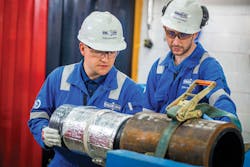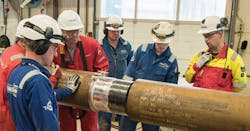All-polymer connector improves pipeline corrosion mitigation
Equinor qualifies technology for water injection applications
Allan Feeney and Chris Woods,Swagelining
Research suggeststhat more than half (51%) of all failures in traditional oil and gas pipelines are due to internal corrosion.1 The failure of any pipeline presents business risk, from loss of production to cost of correction. Deeper water projects and more aggressive fluids have traditionally led to increased pipeline and riser wall thickness. However, alternative mitigation options are evolving at pace to remove the risk and lower the cost of pipeline ownership. The past decade has seen a rapid advance in the development and qualification of polymer materials as an internal lining for carbon steel pipelines.
Acting as a barrier between transported fluids within a host pipe, polymer liners have evolved from widespread use within onshore utility pipeline systems, to become a more practical and economical solution for offshore pipelines. However, their uptake to date has been restricted due to the need for costly corrosion resistant alloy (CRA) connectors and complex CRA welding processes.
LinerBridge, when used as part of an integrated polymer lining system, improves the sustainability of fluid transport systems. (All images courtesy Swagelining)
World’s first all-polymer connector
Developed by Swagelining (a Subsea 7 company), LinerBridge is the world’s first all-polymer connector qualified by DNV GL to technology readiness level five (TRL 5). The connector, which is made from the same material as that of the polymer liner, is an integral component of the company’s integrated polymer-lining system.
By preventing the transported medium from coming into contact with the carbon steel pipe, it not only provides a continuous end-to-end polymer corrosion barrier, but also it facilitates the use of a carbon steel welding process in joining lengths of host pipeline. Thereby, reducing fabrication costs, weight, installation costs, and scheduling. This is unlike polymer-lined pipelines using CRA connectors that have exposed CRA transitions and require complex CRA welding processes.
As an all-polymer connector system, the technology is also well suited to high fatigue environments, enabling its use in deepwater steel catenary riser (SCR) systems which has previously not been possible. With field developments taking place in increasingly deeper waters and development of high-pressure/high-temperature (HP/HT) fields driving increased water injection pressures, flexible risers are challenged in terms of fatigue due to their construction without becoming prohibitively heavy. A polymer-lined SCR can offer clients’ substantial benefits in terms of riser cost, integrity, and floating production unit hang-off tension.
The technology is the world’s first all-polymer connector qualified by DNV GL.
In line with DNV-RP-A203, the recommended practice for qualification of new technology, the connector is qualified for onshore and offshore applications. It is suitable for subsea installation methods such as reel-lay and towed pipeline bundles. When used in reel-lay, the connector enables engineering, procurement, construction, and installation (EPCI) cost reductions of more than one-third when compared with alternative CRA lined pipe.
The qualification assures that the all-polymer connector is qualified for pressures up to 380 bar (5,511 psi) across 8-in. to 16-in. diameter water injection pipelines, with temperatures ranging from 0°C to 60°C (32°F to 140°F). An engineering assessment for periodic fluctuations above 60 degrees can be made with a maximum of 80°C (176°F) for PE100 material and to 95°C (203°F) for PE-RT material.
Further hydrostatic testing is ongoing within the company to raise the qualified pressure above the current 380 bar to address the growing demand for extreme high-pressure water injection systems which are now requiring up to 900 bar (13,053 psi).
Industry endorsement
Following success in a recent qualification plan, Equinor has also qualified the all-polymer connector for use in its water injection applications. After undergoing simulated reeling, hydrostatic testing, and accelerated age testing, Swagelining’s integrated liner system, incorporating the LinerBridge connector – maintained its integrity and corrosion barrier.
During the testing and qualification phase with both DNV GL and Equinor, the company demonstrated that the connector is a viable alternative to conventional CRA methods and provides a tough, reliable, and fully integrated polymer barrier within the pipeline at reduced installation costs and with less ongoing maintenance requirements.
As well as showing its cost reduction potential and long-term durability as a barrier, the connector offers improved flow assurance and pigability through near continuous bore diameter with a smooth transition across the connector. It also facilitates improved flexibility in pipeline construction as it can be installed at any point in a length of polymer-lined pipeline facilitating cut-to-length operations and repairs.
Proven performance under pressure
Finite element analysis modeling was used to demonstrate how the polymer connector behaves when subject to varying degrees of internal pressure. The connector is engineered to be fully supported by the steel host pipe following initial internal pressurization. Full deflection of the connector body is complete after the internal pressure reaches around 70 bar (1,015 psi).
Up to this full deflection pressure, the tensile and shear stresses on the electrofusion joint are demonstrated well within material limits. Beyond this full deflection pressure, they remain constant, with the predominant stresses on the connector becoming compressive due to the fact that the polymer is being compressed into the steel pipe surface. Essentially, it is the steel pipe which takes the actual pressure containment and the liner simply compresses within the steel pipe.
Weld integrity verification
LinerBridge uses proven electrofusion welding technology adapted from the onshore gas utilities industry. Due to the extreme subsea environment, the quality of the polymer weld was rigorously tested to ensure it conformed to and exceeded the acceptance criteria in ISO 13954, for electrofusion assemblies of nominal outside diameter greater than or equal to 90 mm (3.5 in.).
This standard calls for the testing of four samples as a minimum. Dependent on the connector size, the company internally test a minimum of 12 samples per side to demonstrate the required joint quality is throughout the 360 degrees of the electrofusion joint.
As non-destructive testing to verify the weld quality and agreed acceptance criteria is not viable or mature for polymer materials, the company performs pre-qualification testing to ensure the connector is suitable for the pipeline environment before fabrication. By welding the connector system within a process envelope, it takes into consideration the environmental temperature, electrofusion welding time, and the internal diameter of the machined seat. Therefore, when on onsite, this ensures the connector is installed within that process window, as well adhering to strict installation procedures, which are designed to control variables like contamination.
The connector forms part of an integrated polymer barrier, preventing the transported medium from coming into contact with the carbon steel pipe.
A sustainable solution
While seven years is the typical life expectancy of an unlined carbon steel water injection pipeline2, the connector and integrated lining system have a qualified design life of 50 years. This is based on project-specific test conditions without any detrimental impact on the polymer liner. The ability to extend the lifetime of the pipeline was proven following accelerated age testing with the Norwegian operator, and subsequently reviewed by DNV GL, as part of the independent verification process.
Integrated polymer systems can significantly lower the cost of full life-cycle pipeline ownership, while preserving system integrity. Lower installation costs combined with less long-term maintenance are seeing greater uptake of this new material.
This technology therefore increases the cost-effectiveness of polymer lining systems, enabling a step-change in the mitigation of internal corrosion for pipelines and risers.
LinerBridge will be installed as part of an integrated polymer lining system in a pipeline bundle in 2018 and as part of two reel-lay projects in 2019. •
References
1. https://www.ogj.com/articles/print/volume-88/issue-44/in-this-issue/pipeline/corrosion-causes-most-pipeline-failures-in-gulf-of-mexico.html
2. Failure of Water Injection Lines JIP, by AEA Technology, July 1997.



